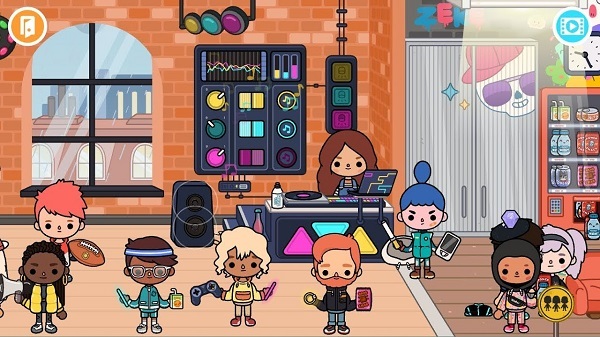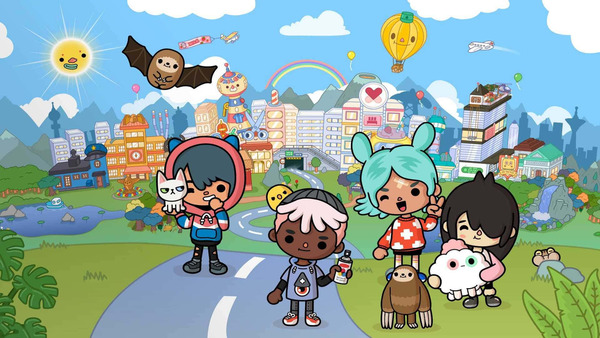Introduction
Toca Life offers a vast, open-world playground where players can create stories and explore their imagination. However, creating complex character roleplay within the game comes with unique challenges. Many players find it difficult to make their character interactions feel realistic and engaging. In this article, we’ll explore the intricacies of roleplaying in Toca Life, focusing on how to bring out the depth of character personalities, set up meaningful scenarios, and maintain coherence across multiple storylines. Let’s dive into the specifics to make roleplaying in Toca Life both engaging and seamless.
Building Character Personalities: The Foundation of Roleplay
Creating unique character personalities is essential to developing engaging storylines in Toca Life.

Creating unique character personalities is essential to developing engaging storylines in Toca Life.
Establishing Distinct Personalities
To create vibrant characters, players should assign specific personality traits to each one. This makes each character feel individual and gives depth to their interactions.
Tips for Defining Personalities
List Traits: Choose a few core traits for each character, like “curious,” “brave,” or “shy.”
Assign Motivations: Decide what drives each character. Are they seeking adventure, friendship, or simply having fun?
Add Quirks: Small habits or preferences can make characters memorable, such as always eating at a certain café or avoiding the hospital.
Exploring Character Dynamics
Characters in Toca Life can have complex relationships, which enriches roleplay. Think about their friendships, rivalries, and family ties.
Setting Up Relationships
Best Friends or Rivals: Establish pairs or groups that share unique bonds.
Creating Tension: Characters with opposing goals can add excitement, such as one trying to keep secrets and another trying to uncover them.
Designing Story Arcs for Characters
Once characters have personalities, story arcs allow players to explore their development and growth in a structured way.
Starting with Short Arcs
Shorter stories are ideal for beginners in roleplay, offering a quick and manageable way to explore characters.
Example Story Ideas
Lost and Found: A character loses a beloved item, prompting a search that reveals their insecurities.
New Friend in Town: A new character arrives, creating a mix of excitement and jealousy among friends.
Expanding to Long-Term Arcs
Longer arcs are suited for more experienced role-players, allowing them to explore deeper character growth and complex plots.
Examples of Long-Term Arcs
Family Secrets: A character discovers hidden family history, affecting their relationships.
Career Goals: A character working towards a dream job or talent, facing successes and setbacks along the way.
Setting Up Environments for Engaging Roleplay
The game’s diverse locations are the perfect backdrops for different story themes and events.
Selecting Locations Based on Mood
Every location in Toca Life has a distinct vibe, from the lively mall to the quiet forest. Use these settings to create the right atmosphere for each scene.
Mood-Based Location Ideas
The Mall for Social Scenes: Great for hangouts, misunderstandings, or finding new items.
Hospital for Dramatic Scenes: Use the hospital for character accidents or visits that evoke concern.
Transforming Ordinary Spaces
With creativity, even familiar locations can be reinvented into exciting venues for new stories.
Keeping Track of Character Development
As characters evolve, keeping notes on their progress helps maintain story consistency.
Using Journals to Record Progress
Keeping a “character journal” is a helpful way to track each character’s journey, motivations, and relationships.
What to Include in Journals
Story Milestones: Note any significant event that affects the character.
Relationship Changes: Track shifts in friendships or conflicts for consistency.
Evaluating Character Growth
Players can periodically assess how much each character has developed and whether new traits or goals need to be added.
Crafting Dialogue for Realistic Interaction
Dialogue brings life to character interactions, making roleplay feel natural and engaging.
Writing in Character Voices
Characters should speak in a way that reflects their personality. For example, a shy character might use shorter, softer sentences.
Sample Dialogues
Excited Character: “Oh my gosh! We have to go now! I can’t wait another second!”
Reserved Character: “Um… I’m not sure. Maybe we could try it tomorrow?”
Using Dialogue for Conflict and Resolution
Dialogue is also a powerful way to convey misunderstandings or resolve conflicts.

Dialogue is also a powerful way to convey misunderstandings or resolve conflicts.
Creating Plot Twists for Excitement
Unexpected events keep stories fresh and characters engaged. Plot twists should be relevant to the characters and fit naturally within the storyline.
Introducing Small Twists
Small surprises, like a character receiving an anonymous letter, can create mystery and intrigue without needing an elaborate setup.
Examples of Small Twists
Hidden Treasure: A character stumbles upon a hidden map leading to a new adventure.
Secret Revealed: Someone accidentally shares a friend’s secret, leading to new conflict.
Planning Major Twists
For more complex roleplay, larger twists can reshape the entire story, like a character moving away or a business closing down.
Balancing Individual and Group Storylines
Balancing character-driven plots with group interactions keeps the narrative varied and engaging.
Exploring Solo Stories
Giving characters solo moments allows them to shine individually and explore personal goals or fears.
Solo Story Ideas
Self-Discovery: A character tries a new hobby and discovers hidden talents.
Challenge: A character faces a challenge, such as learning to stand up for themselves.
Integrating Group Stories
Group stories can focus on friendships, teamwork, or shared adventures, showcasing different dynamics.
Using Props and Outfits for Roleplay Enhancement
Props and costumes can significantly enrich the character roleplay experience, adding visual depth to the narrative.
Selecting Thematic Props
Props allow characters to express their personalities and actions more vividly, whether through food items, gifts, or accessories.
Prop Ideas
Music Instruments for Musicians: Perfect for a character who wants to start a band.
Medical Kits for Healers: Useful for hospital scenes or caring characters.
Changing Outfits to Reflect Story Progress
Characters can change clothes based on the events they attend, adding visual continuity and excitement.
Handling Story Consistency in Complex Plots
As stories evolve, it can be challenging to keep all the elements consistent. Planning helps to avoid contradictions and maintain a coherent narrative.
Creating Timeline Templates
A timeline template organizes events in sequence, helping players visualize how each plot point connects.
What to Include in Timelines
Main Events: Major moments or turning points in the story.
Character Reactions: How each character responds to events.
Double-Checking for Plot Holes
Reviewing past events ensures that all character actions and story developments are consistent.
Engaging with Community for Inspiration
Sharing story ideas and character progress with others in the Toca Life community can spark creativity and offer fresh perspectives.
Posting Stories Online
Platforms like forums or social media allow players to share storylines, receive feedback, and learn from other storytellers.
Benefits of Community Engagement
New Ideas: Hearing others’ stories may inspire new directions or ideas.
Improvement Feedback: Constructive feedback can help players refine their roleplaying skills.

Constructive feedback can help players refine their roleplaying skills.
Conclusion
Roleplaying in Toca Life offers endless opportunities to explore creativity, develop rich character stories, and engage in meaningful storytelling. By focusing on detailed character creation, immersive environments, and consistent plot development, players can bring their narratives to life in ways that feel both exciting and personal. The roleplay challenge in Toca Life isn’t just about building stories; it’s about learning to express characters and create worlds that resonate, grow, and inspire others to do the same.


